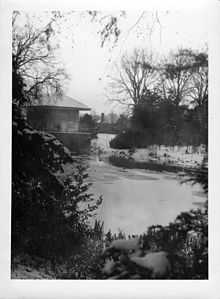Beckett Hall
Beckett Hall (or Beckett House) is a country house at Shrivenham in the English county of Oxfordshire (formerly in Berkshire). The present house dates from 1831.

History
This ancient historical manor is first mentioned in the Domesday survey, and acquired by King John in 1204.[1]
The King holds Scrivenham in the demesne [domain] that King Edward held it. There are 46 hides. There is land for 33 ploughs. On the demesne there are 4 ploughs and there 80 villeins and 17 borderers with 30 ploughs...In the Manor are two mills worth twenty shillings, and 240 acres (0.97 km2) of meadow and woodland to render 20 swine. In the time of King Edward it was worth 35 pounds, and afterwards 20, not 45 pounds.
The property was held by William, the Count of Evreux, on behalf of King John who occasionally made residence there. In return for service, King John granted ownership of the estate to the de Becote family who held the manor until 1424.
In 1633, the Manor was bought by Sir Henry Marten, a judge, then inherited by his son Henry Marten, a prominent Civil War politician and one of the regicides of King Charles I. In 1648, the house was ransacked by royalists.[2] On the son Henry Marten's death, the lands were sold to Sir George Pratt.[3]
In 1666, John Wildman bought the property. Wildman's son adopted John Shute as his heir. In 1716, John Shute was bequeathed the Barrington name by Francis Barrington and inherited the Beckett Estates. He was also the recipient of a newly created Peerage of Ireland, Viscount Barrington of Ardglass. He changed his name to John Shute Barrington, and established Beckett as the family seat. The Barrington family held the estate for many years.
In 1938, Beckett Hall was acquired by the War Office for use as an Artillery School. During World War II, it became an Officer Cadet Training Unit with up to 10,000 US troops based in the area, run and operated by United States Army Forces in the British Isles or European Theater of Operations United States Army (ETOUSA). In 1946, Beckett Hall became home to the "Royal Military College of Science", now known as Defence College of Management and Technology, and served as an officers mess, then as the college library. The College has since vacated the Hall, moving to a new building on the DCMT campus, and the Hall has become a management centre. A modern extension has been built providing accommodation.
The House is a Grade II listed building;[4] The China House in the grounds, traditionally seen as the work of Inigo Jones is a Grade I listed building.[5]
Notable residents
Notable residents include:
- Henry Marten - English politician, regicide and resident of Beckett Hall
- John Wildman - English politician and republican agitator
- John Shute Barrington, 1st Viscount Barrington - English statesman and 1st Viscount Barrington, resident of Beckett, Shrivenham
- William Barrington, 2nd Viscount Barrington - British politician and eldest son of John Shute Barrington
- Samuel Barrington - British Admiral and fourth son of John Shute Barrington
- Shute Barrington, Bishop of Llandaff, of Salisbury and of Durham
Legacy
The estate and the Barrington family who lived there were the inspirations for the naming of Becket, Massachusetts and Great Barrington, Massachusetts.
References
- ↑ Discover Oxfordshire villages: Shrivenham Archived October 14, 2006 at the Wayback Machine cite: Oxfordshire Federation of Women's Institutes (1999). The New Oxfordshire Village Book. Newbury: Countryside Books and the O.F.W.I. ISBN 1-85306-090-9.
- ↑ Taylor, Amanda (2006) Henry 'Harry, the Regicide' Colonel MARTEN at the Wayback Machine (archived August 28, 2008)
- ↑ Pearl, Dan, ed. (Fall 2003). "Searching for Mr. Becket" (PDF). The NEFFA News (the New England Folk Festival Association) 29 (3). Retrieved October 2011.
- ↑ Author N/A (21 July 1982). "IoE Number: 250588. Location: Royal Military Collage of Science, Beckett Hall, Faringdon Road (north side) Shrivenham, Vale of White Horse, Oxfordshire".
- ↑ Belcher, Tim (6 November 2007). "IoE Number: 250589: Location: China House to west of Beckett Hall, Faringdon Road, Shrivenham, Vale of White Horse, Oxfordshire".
Further reading
- Nash Ford, David (2010). "Royal Berkshire History: Beckett House". Nash Ford Publishing.